 |  B&W DM 602 Series 3 Surround Speaker System Thomas J. Norton, September, 2003
 The
model designation "DM" might not sound like anything special, but it
has a long history with B&W. Models such as the DM 6, fondly
remembered by audiophiles as the "pregnant penguin," enjoyed a modest
following in the 1970s, when then-small English speaker company Bowers
& Wilkins was knocking out attendees at hi-fi show demonstrations.
B&W is now, by most accounts, the biggest speaker company in the
UK. Its model range has increased exponentially since those early days,
but the DM prefix is still very much alive. 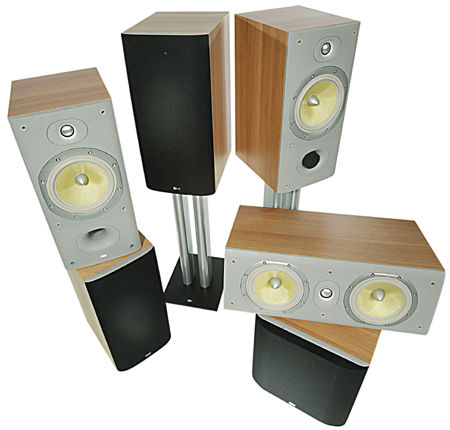
The
DM 600 line doesn't go back quite as far as the company itself—it only
seems to. In this new Series 3 generation, the DM 600 remains one of
the biggest bargains in audio—at least judging from the system that was
the subject of this review. Ins and Outs
The two-way DM 602 S3 is the heart of the system we requested for
review. It's the largest bookshelf model in the model lineup, which
includes the smaller DM 600 S3 and DM 601 S3, plus three floorstanders
and two other models that can function either as center- or
main-channel speakers. B&W
has added some significant refinements to all the new models, many of
them filtered down from the development work done for the company's
flagship Nautilus line. As in the Series 2, the tweeter incorporates a
tubular loading chamber, similar to that used in the Nautilus, to
minimize reflections on the back of the dome. But here a newly
stiffened bond connecting the voice coil and dome extends the
high-frequency range to a rated 30kHz (–6dB). The DM 602 S3, with
its 7-inch driver, is rated down to 43Hz (–6dB)—a range well suited to
trouble-free blending with a good subwoofer. B&W has used woven
Kevlar as a cone material in its woofer/midrange drivers since the
1970s, with continual subsequent refinements. The Kevlar drivers used
in the new models include a more open basket structure than in the
Series 2 designs, and, like the tweeter, have upgraded bonding between
the voice coil and cone. One obvious feature of the
woofer/midrange driver is the bullet-shaped device visible at the
center of the cone. Such devices, known as phase plugs, are typically
used to smooth a speaker's response. In most applications, they are
attached directly to the pole piece, part of the stationary magnet
structure of the driver, and do not move. The phase plugs in the DM 602
S3 and LCR 600 S3 are attached to (and move with) the cone itself, so
they also double as dustcaps. Crossover refinements in the Series
3 include newly selected capacitors chosen after extensive listening
tests. Readers new to audiophilia may scoff at the notion that
different brands and types of components that have identical specs—and
even test the same using conventional measurements—can have different
audible effects on the sound. Not everyone agrees with this—it's as
controversial as audible differences among cables. But many of us at
the Guide have heard such differences for ourselves, and more
than one specialist audio manufacturer evaluates equivalently rated
parts from different sources as part of its product-design listening
tests. The enclosure of the DM 602 S3 is heavily braced. As in
the last version, it uses B&W's FlowPort, a dimpled, tapered port
outlet said to minimize turbulence and the noise that can result from
it. B&W also provides foam plugs that can be inserted in the port
to damp its output. This changes the speaker's bass characteristics and
may be desirable in some installations. The only way you'll know which
works better in your system is to experiment. I found that my setup
worked best without the plugs; the bulk of the auditioning (and all of
the measuring) was done with open ports. All of the technology
described above is also found in the LCR 600 S3, a speaker very much a
part of the DM 600 series despite the lack of "DM" in its model number.
(B&W probably felt that a model called the "DM LCR 600 Series 3"
would fail the dealer tongue-twister test.) This speaker can be used
horizontally as a center-channel, as I did, or positioned vertically
and used for other channels as well. The LCR 600 S3 has two woofers,
which are slightly smaller than the one in the 602, and a 21/2-way
crossover. Both woofers operate up to 300Hz, but one driver rolls off
above that frequency, leaving the other one to handle the 300Hz–4kHz
range. The LCR 600 S3's port is at the rear, and the speaker is
magnetically shielded. The DM 602 S3 is not shielded—presumably because
the left and right speakers will be at least a few feet from any
television susceptible to magnetic fields. (CRT-based sets are
susceptible; those based on plasma, LCD, LCoS, and DLP are not.) Both
the DM 602 S3 and the LCR 600 S3 have two sets of terminals and can be
biwired or biamped, as desired. I used single wiring for all of my
listening. The ASW 675 subwoofer has been designed specifically
for the new DM600 line, although, like all subwoofers, it can be used
with other speakers. Its 10-inch driver has a long-throw suspension and
a composite cone of Kevlar, pulp, and aluminum, driven by a 500W,
class-D amplifier with a switching-mode power supply. Controls include
level and crossover-frequency knobs, a switch to defeat the internal
crossover for use with pre-pros and A/V receivers that have their own
bass management (i.e., most of them), an 80Hz highpass filter that will
most likely be used in 2-channel systems that lack bass management, a
signal-sensing auto-on option, a 0/180° phase switch, and a
two-position equalization control selectable for maximum output or
maximum bass extension. Cosmetically, the entire line has been
completely redesigned. I think it looks great—particularly in the
Sorrento "light oak" finish, a high-quality vinyl veneer—but judge for
yourself. Setup
I used two rooms and two different systems for this review. I broke in
the review samples in my smaller room, approximately 17 feet long by 13
feet wide with an 8.5-foot ceiling. The DM 602 S3s were all mounted on
stands situated at the left and right in both the front and rear. The
front stands were the B&W designs shown in the photos. The center
was perched atop my 50-inch Hitachi rear-projection TV in the small
room, and the subwoofer was parked in the left front corner of the room. All
grilles were removed for the auditions, and no damping plugs were
placed in the speakers' ports. The front left and right speakers were
toed-in toward my listening position in both rooms. All of my listening
was done with the subwoofer engaged and the bass crossovers in the
receiver (small room) and pre-pro (large room) set to 80Hz. The "A"
(maximum extension) position of the subwoofer's equalization switch
produced the deepest bass response, though the difference between "A"
and "B" (maximum output) was insignificant on most program material.  |  | B&W
Web Site
54 Concord Street
North Reading, MA 01864-2699
(978) 664-2870
|
|
|  | |  |
|
 |  Sweet and Lowdown
I started listening in my smaller room. The first thing that struck me
was the B&Ws' open, airy, well-balanced sound. The bass from the
ASW 675 subwoofer was also punchy and solid, without boom. The imaging
was reasonably precise, though the depth was a little foreshortened;
both imaging and depth were likely more constrained by the presence of
a large rear-projection television between the front speakers than by
any inherent limitation of the B&Ws themselves. The
overall sound from the system was a bit laid-back, which made the
treble a little prominent, but the speakers' top end was so clean,
detailed, and sparklingly open that I couldn't work myself up into even
a tepid reviewer's snit about it. And the B&Ws left no question
that they could raise the roof on hyperactive soundtracks, even with
moderate power in a medium-size room. Yes, there was a little
congestion from the system at high levels on some complex material, but
it was minor; otherwise, the 65Wpc Outlaw receiver drove the speakers
without complaint. The soundtrack from U-571 risked legal
action (or at least a visit from the local SWAT team), and even at the
highest levels I could stand, neither the main speakers nor the
subwoofer complained—even during those hair-raising depth-charge
attacks. Provided I did't drive the speakers to silly, head-banger
levels—every speaker has its limit—they never sounded offensive or
grating. The only reservation I had was a slightly woofy quality from
the LCR 600 S3 center-channel on male voices, particularly off-axis. It
wasn't difficult to adjust to—after a week or so I had to remind myself
to listen for it—but it still kept the timbre of the front three
speakers from being perfectly consistent. The same open
transparency I heard on soundtracks was also apparent on music. Driving
only the left and right speakers plus the subwoofer in 2-channel stereo
mode produced a natural yet robust and solid sound. Overall, the treble
from the DM 602 S3 sounded a touch dry, and while high-frequency
details were a little more obvious than I've heard from speakers that
measure flat in the treble, the 602 never sounded edgy or bright. The
subwoofer blended seamlessly, with no boom or other constant reminder
that the system included a separate subwoofer. But when the music
needed bass support, the ASW 675 punched through with a low end that
was far tighter, more dynamic, and extended than any full-range speaker
as small as the 602 can manage by itself. The midrange on music
also was consistently clear and uncolored, with perhaps just a touch of
extra immediacy on vocals that wasn't unwelcome. This system—a pair of
DM 602 S3s plus one ASW 675 sub—can easily compete on even terms with
many comparably priced ($1600/pair), floorstanding 2-channel speakers.
You might even find that you prefer it to some systems priced
considerably higher. Movin' On Up
The B&Ws were by no means at their best only in a small room; they
were also at home in my main home-theater space: 26 feet long by 15.5
feet wide, with an 8-foot ceiling. In this system, the fronts and rears
were again placed on stands. The center was mounted below my projection
screen on a low stand made by B&W for their Nautilus series, and
the subwoofer was placed in the right front corner. With
more power now on tap and more room for the speakers to unwind, I was
even more impressed by what the B&Ws could do. Beginning with music
playback—still 2-channel with subwoofer—Rickie Lee Jones' voice on "The
Moon is Made of Gold," from Rob Wasserman's old audiophile standard, Duets
(MCA MCAD-42131), sounded immediate and in the room, but not pushy. On
other selections from this CD, the speakers excelled in soundstaging,
detail, and transparency, with no congestion or obvious coloration.
Only a bit too much sibilance on a few of the vocals suggested a little
too much treble energy. But soundstaging—both imaging and
depth—was also clearly better in the larger space. (The projection
screen was a couple of feet behind the plane of the speakers, making it
less audibly obtrusive than the big-screen TV in the smaller room.)
From the delicate fingering of acoustic guitar to the deepest bass, the
only things I found to criticize about the 2-channel sound of the
B&Ws were the tendency toward a crisp top end and a little lack of
warmth and weight in the "power" region, the range in the audible
spectrum centered around 300–400Hz. Symphonic music, while loaded with
detail and a realistic sense of space, was a bit shy of the majestic
quality that larger speakers—usually far more expensive ones—can
produce. Moving on to movies, the soundtrack from the newly remastered Patriot Games
was a bit too bright in Dolby Digital, but noticeably better in DTS.
Otherwise, the balance was first-rate, with a superb rendering of the
light and airy panpipes and tight, explosive drums of composer James
Horner's exciting score. And Fools Rush In—not an overly
challenging soundtrack, but one of the cleanest and sweetest in my DVD
collection—sounded as good as it does through speakers costing several
times as much as the B&Ws. This soundtrack is loaded with detail,
but the top end is not exaggerated. Still, on some DVDs—and bright ones
aren't hard to find—the B&Ws continued to sound just a little too
crisp. The obvious solution was some sort of cinema equalization in the
receiver or pre-pro. But I liked the sparkle the B&Ws provided on
many soundtracks, and the selectable cinema EQ on the Outlaw pre-pro I
used for much of my listening was a bit too aggressive, reducing the
transparency too much for my taste. Changing over to the much more
expensive Primare SP31.7 pre-pro and A30.5 power amp helped noticeably.
The overall balance remained the same, but now the top end was more
refined. On the last night of my listening tests, I went on an animation binge. The Chubb-Chubbs sounded slightly laid-back, delicate in the high end and solid in the bass, without unnatural emphasis. Scrat's Missing Adventure,
a short subject included on the Ice Age DVD, was well-balanced overall,
with a bottom end strong enough to shake my large room nicely. And the
opening sequence of Titan A.E. was as dynamic and explosive as
you'd expect the violent destruction of the Earth to be, its bottom end
almost alarming enough to set off an earthquake alert here in Southern
California. But the good stuff was not limited to explosions and
seismic disasters. The music on the superbly recorded Fantasia 2000
sounded spectacularly good, with a spread, depth, and envelopment that
were astonishing for a surround speaker package that might well be
considered B&W's entry-level, bread-and-butter line by serious
enthusiasts. Apart from the slightly prominent top end, the only
other reservation I had about the sound of the DM 602 S3 system was a
little heaviness in the lower midrange, obvious primarily on male
dialogue and singing voices. It clearly originated from the LCR 600 S3
center-channel and was evident in both the smaller and larger systems.
This probably won't be a factor in all installations, depending on the
speaker placement, but in any case it wasn't entirely a negative in my
situation on soundtracks. It did add a little welcome warmth to the
overall sonic palette. I had a spare DM 602 S3 on hand (B&W sent
along an extra pair), and when I substituted it as a center-channel
speaker, that extra warmth disappeared. And while the sound from a
center 602 was a little more consistent off-axis and slightly more
balanced on vocals than the LCR 600 S3, the system overall was now just
a little lean with full surround material. If you decide to go
that route and use DM 602 S3s all around, remember that, unlike the LCR
600 S3, the 602 is not magnetically shielded. Nor should it be placed
on its side for center-channel use. And you might have a problem buying
an odd number; the 602s are packaged as pairs. (The extra one could be
used for a center surround in a 6.1 system!) Conclusions
At $2700, this B&W system, built around the DM 602 Series 3
speakers, is not cheap, but compared to what you can pay these days for
a complete home-theater speaker setup, it's still a bargain. It's a
surround package that anyone can appreciate; even in 2-channel mode, it
can compete with many stereo speakers that cost $2700/pair—except that
here you get the bonus of a full 5.1-channel array. It will work well
with modestly priced receivers or separates, but it won't embarrass far
more expensive pre-pros and amps. These B&Ws are special, and
highly recommended.  |  | B&W
Web Site
54 Concord Street
North Reading, MA 01864-2699
(978) 664-2870
|
|
|  | |  |
|
 |  Specifications DM 602 S3 2-driver, 2-way ported-box speaker
Drivers: 1" alloy-dome tweeter,
7" woven-Kevlar bass/midrange cone
Frequency response: 52Hz–20kHz, +/-3dB on reference axis
Frequency range: –6dB @ 43Hz & 30kHz
Harmonic distortion: 1%, 2nd and 3rd harmonics (90dB/m), 60Hz–20kHz
Nominal impedance: 8 ohms (minimum 4ohms)
Crossover frequency: 4kHz
Recommended amplifier power: 25–120W into 8ohms
Sensitivity: 90dB/2.83V/m
Dimensions: 19.3" x 9.3" x 11.5" (HxWxD)
Weight: 23.1 lbs
Price: $600/pair LCR 600 S3 3-driver, 21/2-way, ported-box, magnetically shielded speaker
Drivers: 1" alloy-dome tweeter, two 6.5" woven-Kevlar bass/midrange cones
Frequency response: 58Hz–20kHz, +/-3dB on reference axis
Frequency range: –6dB @ 48Hz & 30kHz
Harmonic distortion: 1%, 2nd and 3rd harmonics (90dB/m), 70Hz–20kHz
Nominal impedance: 8 ohms (minimum 3ohms)
Crossover frequencies: 300Hz, 4kHz
Recommended amplifier power: 25–150W into 8ohms
Sensitivity: 89dB/2.83V/m
Dimensions: 21.5" x 8" x 12.2" (WxHxD)
Weight: 27.5 lbs
Price: $500 each ASW 675 sealed-box, powered subwoofer
Driver: 10" long-throw, aluminum/paper/Kevlar cone
System frequency response: 22–110Hz (adjustable, 31–110Hz), +/-3dB
System frequency range: –6dB @ 17 & 140Hz (adjustable)
Amplifier: 500W continuous, 33k ohms input impedance
Dimensions: 13.4" x 13.4" x 16.2" (HxWxD), excluding feet, including rear-panel controls
Weight: 56.1 lbs
Price: $1000 each System
Finishes: black ash, light oak vinyl
Price: $2700 as reviewed; add $45 each for B&W 20" stands Manufacturer
B&W Loudspeakers of America
54 Concord Street
North Reading, MA 01864-2699
tel. (978) 664-2870
Fax (978) 664-4109
www.bwspeakers.com  |  | B&W
Web Site
54 Concord Street
North Reading, MA 01864-2699
(978) 664-2870
|
|
|  | |  |
|
 |  Measurements The
B&W DM 602 S3's bass alignment is tuned to approximately 38Hz (the
minimum impedance magnitude in the "saddle" between the two main
impedance peaks typical of a ported enclosure), with a minimum
impedance of 2.91ohms at 12.5kHz. This high-frequency minimum will not
unduly stress an amplifier, particularly since the phase angle of the
impedance at this frequency is a benign –10°. The next lowest value is
4.73ohms at 172Hz. The 602 should be an easy load to drive for any
competent amplifier. The speaker's sensitivity measured approximately
87dB/W/m across most of the midrange and treble—somewhat lower than
specified, but an average value for a contemporary speaker. All
frequency-response measurements were made with no plugs in the ports.
The horizontal front response of the DM 602 S3 is shown in Fig.1
(violet), the pseudo-anechoic response averaged over a 30° forward
horizontal angle, at tweeter height, and combined with the nearfield
responses of the woofer and port. The 602's effective lower limit
(–10dB at 33Hz) is very good for a speaker of this size, though it
begins rolling off gradually just below 100Hz. 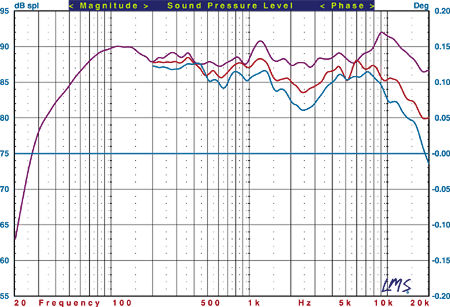
Fig.1: B&W DM 602 S3, pseudo-anechoic response off horizontal axis at 45° (red) and 60° (blue) The
overall 30° front horizontal response of the 602 is smooth from about
200Hz to 7kHz. The main aberration is an obvious rise centered at 9kHz.
This peak is nearly the same on-axis and 15° off-axis, but it smooths
out dramatically at 30° off-axis and is consistent with the
high-frequency response I heard in the listening tests. The high
frequencies roll off smoothly at extreme off-axis angles, though a dip
starts to appear at around 2–3kHz, reflecting the decreased dispersion
of the woofer, which is still active at those frequencies. All
measurements presented here were made with the grilles removed. The
response of the 602 was also measured on-axis with the grilles in
place, in which case it was noticeably more erratic through the upper
midrange and low treble, but with no significant effect on the 9kHz
peak. The vertical response shown in Fig.2 indicates that the DM
602 S3 should sound best when the height of the listener's ears is as
close as possible to that of the tweeter. Standing up puts a pronounced
dip in the presence region—something to keep in mind when auditioning
these speakers. 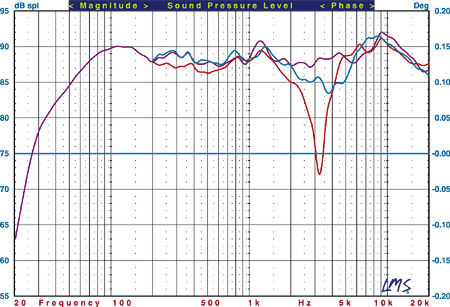
Fig.2: B&W DM 602 S3, pseudo-anechoic response at 15° above (red) and 15° below (blue) tweeter. The
LCR 600 S3 center-channel speaker is tuned to about 33Hz. Its impedance
reaches a minimum of 3.1ohms at 14.5kHz, but, as noted above, this is
less significant than the 5.1ohms minimum at 33Hz. In any case, the
speaker should be a relatively easy load to drive. Its sensitivity
measured approximately 87dB/W/m. The LCR 600 S3's measured front
horizontal response, taken on the tweeter axis and averaged in the same
manner as described above for the DM 602 S3, is shown in Fig.3a and
Fig.3b. The speaker's effective lower limit (–10dB) is approximately
45Hz. Because of the 21/2-way design of the crossover, the 600's
horizontal dispersion is asymmetrical; that is, different in different
directions. Such a 21/2-way network may have useful characteristics,
but improving the horizontal dispersion of a horizontally configured
center-channel is not one of them, as we have seen in other, similar
designs. While it isn't shown here, even sitting 15° off-axis on the
side nearest the port results in a dip of about 5dB centered at about
4kHz. This explains the slight woofy quality noted in the sound,
particularly on vocals. 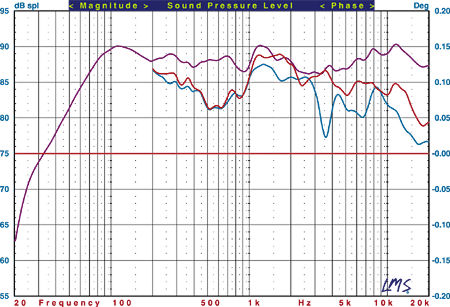
Fig.3a: B&W LCR 600 S3, pseudo-anechoic response off horizontal axis at 45° (red) and 60° (blue) in direction of port. 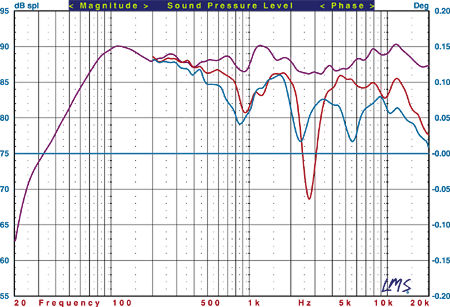
Fig.3b:
B&W LCR 600 S3, pseudo-anechoic response off horizontal axis at 45°
(red) and 60° (blue) in direction away from port. The 600 S3's
vertical off-axis response is very smooth (Fig.4). In fact, it is
actually a little flatter at +/-15° than it is on-axis, suggesting that
the speaker might sound best when not aimed directly at the listener in
the vertical plane. For example, when placing the 600 atop a big-screen
TV, aim it straight ahead rather than angled down. 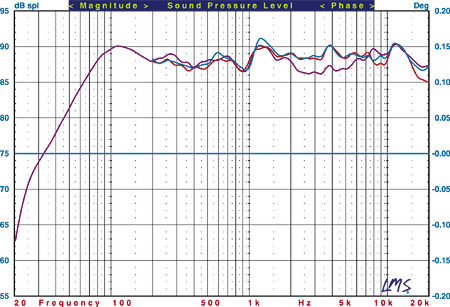
Fig.4: B&W LCR 600 S3, pseudo-anechoic response at 15° above (red) and 15° below (blue) tweeter. The
measurements of the DM 602 S3 and LCR 600 S3 are good for speakers in
this price range. The only two results that gave me pause were the
602's peak at 9kHz and the 600's horizontal off-axis response
deviations. Neither problem area was as obvious on normal program
material as the measurements might suggest, though the high-frequency
rise in the 602 did make the speaker more critical of brightness in the
program material and/or associated components. The 600's horizontal
off-axis dispersion is typical of nearly every 2- or 21/2-way
center-channel we have tested in which the drivers are oriented
horizontally. The best way to optimize such a speaker is with a 3-way
design in which the midrange and tweeter are mounted one above the
other, flanked by woofers on each side. B&W uses this approach in
its more upscale models, but it isn't cheap to do well.—TJN  |  | B&W
Web Site
54 Concord Street
North Reading, MA 01864-2699
(978) 664-2870
|
|
|  | |  |
|
|

